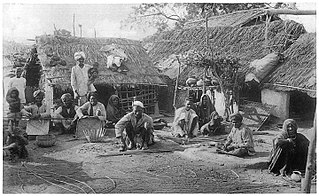
The Badhik, or sometimes pronounced Badhak a Hindu caste engages in the profession of butcher are found in the states of Uttar Pradesh, Rajasthan and Haryana in India. They have been granted scheduled caste status in Uttar Pradesh. [1]

Caste is a form of social stratification characterized by endogamy, hereditary transmission of a lifestyle which often includes an occupation, status in a hierarchy, customary social interaction, and exclusion. It is an extreme evolution of a system of legally-entrenched social classes, also endogamous and hereditary, such as that of feudal Europe. Although caste systems exist in various regions, its paradigmatic ethnographic example is the division of Indian society into rigid social groups, with roots in India's ancient history and persisting until today; it is sometimes used as an analogical basis for the study of caste-like social divisions existing outside India. In biology, the term is applied to role stratification in eusocial animals like ants and termites, though the analogy is imperfect as these also involve extremely stratified reproduction.

Uttar Pradesh is a state considered to be part of central, northern and north-central India. Abbreviated as UP, it is the most populous state in the Republic of India as well as the most populous country subdivision in the world. It is located in the north-central region of the Indian subcontinent, has over 200 million inhabitants. It was created on 1 April 1937 as the United Provinces of Agra and Oudh during British rule, and was renamed Uttar Pradesh in 1950. The state is divided into 18 divisions and 75 districts with the capital being Lucknow. The main ethnic group is the Hindavi people, forming the demographic plurality. On 9 November 2000, a new state, Uttarakhand, was carved out from the state's Himalayan hill region. The two major rivers of the state, the Ganga and Yamuna, join at Allahabad (Prayagraj) and then flow as the Ganges further east. Hindi is the most widely spoken language and is also the official language of the state.

Rajasthan is a state in northern India. The state covers an area of 342,239 square kilometres (132,139 sq mi) or 10.4 percent of the total geographical area of India. It is the largest Indian state by area and the seventh largest by population. Rajasthan is located on the northwestern side of India, where it comprises most of the wide and inhospitable Thar Desert and shares a border with the Pakistani provinces of Punjab to the northwest and Sindh to the west, along the Sutlej-Indus river valley. Elsewhere it is bordered by five other Indian states: Punjab to the north; Haryana and Uttar Pradesh to the northeast; Madhya Pradesh to the southeast; and Gujarat to the southwest.
